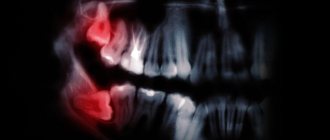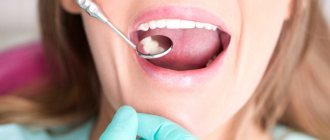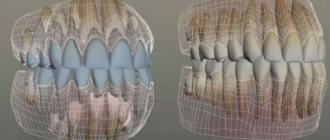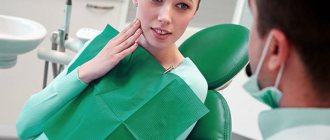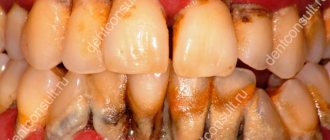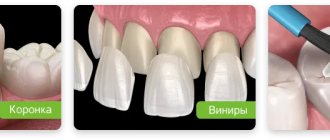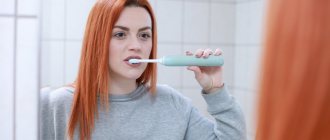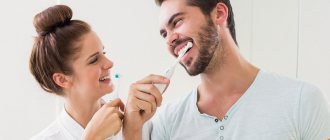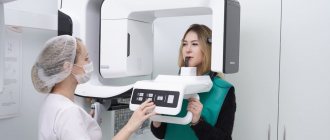Teeth before hygiene, chemical agent for staining plaque (used for educational purposes so that the patient can see areas that cannot be cleaned) and the state after hygiene.
There are a lot of questions about brushing your teeth, so let’s go over the main ones:
- What happens if you don't brush your teeth?
- Is it possible to brush your teeth rarely, but go to the dentist from time to time so that he can “powerfully clean” them for you?
- How is teeth cleaning performed in dentistry?
- Why do the Swiss brush their teeth without toothpaste at all?
- Does chewing gum work?
- Which brushes to choose and how? What about electric ones?
- Is it true that you should throw away the brush when at least one lint deviates from the vertical?
- Why do we need tongue scrapers, interdental brushes, dental floss and everything else?
- Does an irrigator replace brushing your teeth?
- Is mouthwash a good topic?
- When is it more important to brush your teeth - in the morning or in the evening?
- How does an IT professional differ from the average patient's oral health history?
Why brush your teeth at all? What happens if you don't touch them?
The oral cavity is the site of an ongoing battle between approximately 700 species of microflora.
Saliva is one of the most active fluids in the body. On the one hand, it must neutralize biological threats from the outside world, on the other, pre-process food, and on the third, protect teeth. From the point of view of evolutionary biodesign, the problem is solved very well if you eat what evolutionary biodesign offers from the outside world. For example, apples, large animals with tough meat, then unripe wild pears, carrots, and so on. Hard food cleans teeth perfectly without your help. Several tens of thousands of years ago, something went wrong, and man learned to cook food over fire. This gave rise to the first problems, but at that time they were not very significant, since in the light of the development of medicine and the lack of antibiotics, teeth were not the most important problem. But already in the twentieth century, when fast food, forced high-carbohydrate diets and soft, inconsistent food entered the masses, real difficulties began.
Plaque is a biofilm of bacteria that sticks to your teeth and does its best to protect itself from aggressive saliva and other cleaning methods. In this regard, bacteria are greatly helped by adhesive microfragments of food, which remain in the form of such glue on the teeth. For example, crumbly cookies or pizza dough combined with dead cells create a good bioglue. Bacteria land on it and begin to colonize your tooth. Their goal is to get inside and set up a base there. We call this caries. Most often, developed caries is just amphora-shaped: a small entrance hole and a sea of destruction inside the tooth.
This is how the patient comes:
Here is hidden caries revealed:
And here is the end of the therapist’s work:
Hidden caries can, in principle, be detected by radiography and transillumination.
If you remove this biofilm in time, there will be no caries. But it is quite strong, so either a strong antiseptic is needed (the same alcohol, which also harms other parts of the system, starting with the oral cavity), or mechanical treatment (with an apple or a toothbrush). A large amount of saliva partially washes away the films, but not all of them: for example, they remain at contact points and under the edge of the gums.
Several layers of biofilm form a calculus - tartar. This is a pretty disgusting reinforcement of bacteria. It is disgusting with its unique smell and taste (which your partner often feels with every kiss). But from a medical point of view, this is not the main thing. The main thing is that tartar still puts pressure on the gums and impedes the blood supply to the gums, creating complex inflammations. Well, no one ruled out caries. Imagine that several grains of sand have stuck into your hand, and they stick out there for months, gradually increasing in size. Tartars are about as unpleasant, but due to the nature of their innervation, you almost don’t feel them.
So, if you don’t brush your teeth, a biofilm will form very quickly. And if you don’t touch the biofilm, a calculus forms, which triggers many unpleasant processes. It is an accepted medical practice to brush your teeth after breakfast and dinner.
When is it more important to brush your teeth - in the morning or in the evening?
It may seem that brushing your teeth in the morning and at night is equally important.
But no, evening cleansing is much more important. At night, your body produces less saliva (this is one of the reasons why your mouth is dry in the morning). Less saliva on your teeth means less protection for them. Less protection means faster biofilm formation. That is, if you brush your teeth in the morning so that your breath does not smell when talking, then in the evening you need to brush your teeth for medical reasons. Most teeth brushing techniques suggest that evening brushing should be longer than morning brushing.
In the dictionary Complete accentuated paradigm according to A. A. Zaliznya
clean, clean, clean, clean, clean, clean, clean, clean, cleaning, cleaned, cleaned, cleaned, cleaned, clean, clean, clean, clean, cleaning, cleaning, chi cleaning, cleaning, cleaning, cleaning, cleaning, cleaning, cleaning, cleaning, cleaning, cleaning, cleaning, cleaning, cleaning, cleaning, cleaning, cleaning, cleaning, cleaning, cleaning, cleaning, cleaning, cleaning, cleaning, chi cleaning, cleaning, cleaning, cleaning, cleaning, cleaning, cleaning, cleaning, cleaning, cleaned, cleaned, cleaned, cleaned, cleaned, cleaned, cleaned, cleaned, cleaned, cleaned, cleaned, cleaned, cleaned, cleaned, cleaned, cleaned, cleaned, cleaned lice, cleaned, cleaned, cleaned, cleaned, cleaned, cleaned, cleaned, cleaning, being cleaned, being cleaned, being cleaned, being cleaned, being cleaned, being cleaned, being cleaned, being cleaned, being cleaned, being cleaned, being cleaned, being cleaned, being cleaned, being cleaned, being cleaned, being cleaned, being cleaned, being cleaned, being cleaned, being cleaned, being cleaned, being cleaned, being cleaned, being cleaned, being cleaned, being cleaned, being cleaned, being cleaned, being cleaned, being cleaned, being cleaned, being cleaned, being cleaned, being cleaned, being cleaned, being cleaned, being cleaned, being cleaned, being cleaned, cleanable, being cleaned, being cleaned, being cleaned, being cleaned, being cleaned, being cleaned, being cleaned, being cleaned, being cleaned, being cleaned, being cleaned, being cleaned, being cleaned, being cleaned, being cleaned, being cleaned, being cleaned, being cleaned, being cleaned, being cleaned, being cleaned, being cleaned, being cleaned, being cleaned , being cleaned, being cleaned, being cleaned, being cleaned, being cleaned, cleaned, cleaned, cleaned, cleaned, cleaned, peeled, peeled, peeled, peeled, peeled, peeled, peeled, peeled, peeled, peeled, peeled, peeled, peeled, peeled, peeled, peeled, peeled, peeled, peeled no, cleaned, cleaned, cleaned, cleaned, cleaned, cleaned, cleaned, cleaned, cleaned, cleaned, cleaned, cleaned, cleaned, cleaned
Share the meaning of the word:
Is it possible to independently assess areas of biological damage?
Yes, you can. To do this, you need to buy either Curaprox, Dynal tablets, or Curaprox, PresiDENT liquid at your nearest pharmacy. The tablets are chewed to a cheerful foam and spat out. Considering that you need to carefully and thoughtfully read the instructions to the end, it is better to buy a liquid; it is applied with a special swab or cotton swab. It will be more reliable. But if you have not had hygiene for the last two to three months, then it is better to do it on Friday evening. In fact, it washes off almost immediately, but there is a chance that particularly severe lesions will be stained for about 50 hours. This happens quite rarely and with poor hygiene, but it is a matter of chance.
In the Dictionary of Synonyms
clean, clear, clear, sweep, brighten, scrape, wash, wash, rinse; filter, strain, settle, reduce (remove) stains; cleanse the Augean stables; to polish, to polish, to polish, to peel, to scold, to peel, to knock out, to scrape, to clear, to scrape out, to scratch, to scold abusively, to scold in the last words, to bastard, to clean off, to scold, to re-clean, to clean up, to wash, to brighten, to polish, to peel, to scold on what is worth, beat, tear, bone, peel, wax, shower with abuse, shower with curses, scrape, wipe, send away, call names, remove, remove, hit, scold, rob, lick, clean, scratch, lick, poke, cover , peel, rob, honor, peel, bake, cover, cleanse. Ant. pollute, pollute
What happens during dental hygiene?
First, the hygienist looks at the size of the stones.
If there are very large ones, then we break them up with ultrasound. Next, we work with the plaque manually using rotating brushes, rubber bands and paste. If you need to get under the gum, there are curette hooks that can be used to clean difficult areas and smooth the surface of the roots so that rotting food does not linger there. Then each gap between the teeth is treated with floss and fine sandpaper. The teeth are then polished. The next stage is strengthening: a disposable mouthguard with a remineralizing solution is placed on the teeth. It then discusses how best to brush your teeth in the future. Then there are two approaches: “industrial” and “archaeological”. If you see sandblasting on soda, then in front of you is a hygienist who wants to do it quickly and powerfully. However, due to the design features of this equipment, it is very difficult to ensure a balance of efficiency and safety, so we consider this approach not the best from the point of view of its relationship to the tissues of the oral cavity (the rough surface of the tooth after a large abrasive gives greater adhesion to sticky food, gum damage is not uncommon). Manufacturing companies are trying to solve this problem, but for now our choice is mechanical contact cleaning.
During cleaning, various chemical agents and “soft” abrasives can be used. If there is inflammation of the gums (which is often associated with “blockages” of stones), then treatment with special antiseptics and agents may be necessary to relieve inflammation. In this case, the appointment is often divided into two: first, the stones above the gum line are removed, then five to seven days pass until the inflammation caused by them subsides, and then the stones below can be worked relatively safely. If you do everything in one go, it won’t be very beautiful: there will be blood in all directions. It’s not that we feel sorry for doing this, it’s just that it prevents us from properly assessing the results of the work inside this bloody mess. That's why we love it when it's clean, the patient doesn't break out and doesn't panic. Gingivitis starting from the middle stage = two doses a week apart.
The procedure itself is painless, but sometimes patients feel ticklish. Sometimes grinding an instrument against your teeth causes unpleasant emotions. There is no problem doing everything under local anesthesia: this is exactly the case when you don’t need to be afraid to ask for it.
Hygiene is done before any more or less serious intervention, since it allows for correct diagnosis later and correctly taking into account the shape of the teeth. Well, the fewer dangerous bacteria there are during invasive procedures near the field, the better.
How to brush your teeth correctly?
A colleague of mine recently wrote about the characteristic “programmer teeth”.
About half of the problems in these cases are associated with insufficient salivation of the oral cavity: this is a completely predictable consequence of night work, stressful focus on the task and various problems with eating. Since I have very little faith that after reading this someone will suddenly start eating right or change their daily routine, let’s tell you how to properly brush your teeth using the Swiss method. It is most suitable for those who have a busy schedule, stress and poor nutrition. That is, for all adults in large cities. It's called the BASS technique (more precisely, the advanced Bass teeth brushing technique). It is one of about two dozen techniques available. Note that we still don't know which teeth cleaning technique is best out of all the different ones out there. If you are interested, this issue was raised in Nature: here is an analysis of recommendations from various sources, textbooks and a selection of studies. The result is that the Bass technique is too complicated for children, but for adults it gives the best results. Moreover, all studies that numerically confirm this were carried out over a fairly short observation period.
Sorry for the compression, this is the original image quality from a study of 180 healthy children.
Blue was and became - this is your usual horizontal brushing, red - circular with closed teeth, green - according to Bass. Here is another study with a longer follow-up period. This is partly due to the fact that it is difficult to follow patients and stand over them every time they brush their teeth. Nevertheless, this method is currently one of the best, judging by scientific data and practice. Here's what to do:
1. Buy a soft toothbrush with the most bristles. The shape is strictly straight (both the handle and the fleecy part without bends or protrusions). You still won’t be able to do anything better with a hard or medium-hard brush, but a soft one cleans much better and without damage: we will work on the border with the gum.
I recommend Curaprox ultrasoft 5460, Revyline, TePe brushes, but you can choose any similar ones.
2. Take the brush like a handle (not in a fist) and place it at a 45-degree angle to the gum vertically, so that the bristles go under the edge of the gum. You will feel it. Half of the brush should be on the crown of the tooth, half on the gum. Next, start moving the brush so that you get such long ovals. Gradually work your way across all teeth from the front, working at the edge of the gum.
Do not move the brush with your elbow or forearm, only with your hand. You should get very soft smooth movements.
3. Brush the inside of your teeth in the same way, but hold the brush vertically.
4. After this, make the usual horizontal movements along the edges of the teeth and their frontal surfaces.
The procedure is slower than usual haphazard cleaning, since you need to go over all the teeth very carefully at the edge with the gum. In the morning it takes three minutes, in the evening - more than five minutes. In Switzerland, people brush their teeth for seven to ten minutes, leaving the bathroom with a brush without toothpaste. This is a very good practice, and I recommend it: just take a brush and sit down to watch YouTube or do something else and work gently along the edge of the gum. The point of the method is not only that you can do something else while brushing your teeth (fortunately there is no toothpaste), but also that you do not see your reflection. When you control a brush based on visual cues, it always dramatically reduces the quality of brushing compared to brushing without a mirror, because different sensory systems are involved. And sensations are more important than vision here.
Review and detailed analysis of all stages of comprehensive teeth cleaning
Professional teeth cleaning is a process of several stages, using certain technologies. Initially, the hygienist removes deposits that have hardened and formed a special stone on the teeth. Such deposits can be eliminated through the use of ultrasonic equipment.
Ultrasonic teeth cleaning
Tartar is hardened (or mineralized, in more professional terms) deposits on certain areas of the tooth.
Based on the area of formation, tartar is divided into supragingival and subgingival. The second type poses the greatest danger to humans, since it very often leads to gum inflammation in the future. Simple methods cannot get rid of such deposits, and only the use of ultrasonic equipment can eliminate them.
When performing cleaning, ultrasonic waves destroy deposits even in the most difficult to reach areas, and at the same time harmful microflora, which can lead to inflammation. Timely use of teeth cleaning will help avoid various dental problems. Such as, for example, periodontitis or periodontal disease.
Dentists use a special device (scaler) to solve these problems. It creates the necessary ultrasonic waves. It has a tip with a special attachment that transmits waves to the areas that need to be treated. It is also supplied with water or antiseptic. The dentist, using the device, can change the intensity of vibrations, selecting the most suitable mode for the patient.
How is tartar removed?
When performing such cleaning, it is destroyed due to the following:
- Ultrasound has a mechanical effect on hardened areas. The waves gently crush the stone into small pieces, which are easily removed with water or a special vacuum cleaner for the oral cavity;
- The simultaneous supply of liquid and ultrasound leads to the formation of a cavitation effect, during which a huge number of microbubbles are created. They blur plaque and speed up its separation from the tooth surface.
Important! Before it became possible to use ultrasound, tartar was removed exclusively with hand tools. Because of this, the procedure was very long and complicated. The dentist could easily injure the soft tissues, since the instrument used was extremely sharp, so the whole procedure could hardly be called pleasant. The most negative point in all this was that during the procedure, tooth enamel was significantly damaged. This was due to the fact that to remove plaque it was necessary to remove a layer of healthy tissue. After performing this type of cleaning, patients often experienced unpleasant dental hypersensitivity. The use of ultrasound allows you to avoid all these problems. Ultrasonic cleaning is absolutely safe; it does not injure the gums or mucous membranes.
It is very important that all procedures are carried out using modern equipment, without any disruptions in the process, only then the cleaning will be carried out professionally and will be safe. To do this, it is important that the hygienist has experience working with a scaler: the tip of the device should move only along areas of the tooth at a specific angle, and the cleaning itself should be accompanied by a significant supply of water to the teeth. It is very important to follow this process technology, since violations can damage the enamel or overheat the pulp, which can lead to various complications.
Our dental clinic carries out such cleaning only under the guidance of professional hygienists, as well as using modern equipment, so patients have nothing to fear and are guaranteed an impeccable result.
Important! A positive feature of using ultrasound, as opposed to other types of cleaning (with the exception of laser cleaning), is that it kills pathogenic microflora. For this reason, this procedure is highly recommended for patients with gum disease, because ultrasound kills pathogenic microflora in all areas, including periodontal pockets.
You should not be afraid of such cleaning, because it does not cause pain at all. If you are concerned that they may occur, you can ask the hygienist to pre-administer anesthesia. With this option there will definitely be no pain. Otherwise, ultrasonic cleaning is very fast. Up to 60 minutes, the exact time depends on how much deposits are observed in the oral area.
Important! If you have hypersensitivity or have a lot of deposits in the subgingival pockets, then there may be some pain during ultrasonic cleaning, and this is normal. In order to remove them, you need to administer anesthesia before cleaning. It can be administered not by injection, but by applying a local application. Therefore, there is no need to be afraid or panic.
Once this stage has been successfully completed, the hygienist moves on to the next stage and performs cleaning using Air Flow technology.
2.Air Flow
During the Air Flow teeth cleaning procedure, a special sandblasting device is used, which, using air and water, delivers a composition with abrasive particles to the enamel surface. The liquid is supplied in a powerful stream, which allows you to cleanse your teeth of bacteria and plaque in a short period of time. This method is effective not only for removing loose deposits, but also pigmented plaque that is firmly embedded in the enamel.
Air Flow is an innovative technology for cleaning teeth, which has a number of undeniable advantages:
- Air Flow easily fights plaque located in hard-to-reach areas of the oral cavity, which helps get rid of bad breath.
- The procedure can be performed without the use of anesthesia. It does not cause pain or discomfort. Mild pain may occur in patients with hypersensitivity.
- During the Air Flow procedure, aromatic liquids are used that can give freshness to your breath and turn cleaning into a pleasant, painless process.
- In liquids for the Air Flow procedure, soda is used, crushed to a powder state. This means that the risk of injury to tooth enamel during the cleaning process is completely eliminated.
- Air Flow effectively removes pigmented plaque. The procedure is indispensable for smokers and lovers of strong coffee and black tea. Excessive consumption of coffee and tobacco negatively affects the whiteness of the enamel, making it yellow. Air Flow quickly removes unpleasant plaque, restoring your teeth to their attractive appearance.
- During cleaning, do not use liquids with caustic chemical composition. This means that cleaning is safe and does not cause allergic reactions or other unpleasant consequences.
- The air-abrasive flow helps restore teeth to their natural white color and make your smile more attractive.
IMPORTANT: Using Air Flow technology, the doctor independently adjusts the power of the water-air flow onto the enamel surface, taking into account the individual characteristics of the patient’s teeth. The dentist takes into account the structure and condition of the enamel and whether there is hypersensitivity. This approach helps to achieve high efficiency and complete safety for patients.
Why does professional cleaning combine two techniques - Air Flow and ultrasound?
This question worries many patients. Hygienists explain that only a combination of two cleanings can achieve the desired result and carry out the procedure for cleansing the oral cavity from bacterial plaque at the proper level.
Air Flow cleaning works great at removing pigmented plaque that has become embedded in the pores of the enamel, but it will not be able to remove hard tartar, and is ineffective in the presence of mineralized deposits located in periodontal pockets.
Ultrasonic cleaning works well to remove tartar, but the metal tip of the scaler cannot penetrate the space between teeth (it is especially difficult to clean the interdental space in patients whose teeth are too close together). That is why these methods are used in combination. During professional cleaning, ultrasound and Air Flow methods are used.
IMPORTANT: Air Flow and ultrasonic cleaning can lighten tooth enamel to a natural level - by 2 tones. For those who want to achieve a more pronounced effect, after cleaning they should resort to a professional whitening procedure.
Teeth polishing is one of the mandatory stages of professional cleaning.
The third stage of brushing your teeth involves mandatory polishing of your teeth. Using polishing, the dentist eliminates all irregularities and microcracks in the enamel that form after cleaning the teeth of accumulated deposits. Professional teeth cleaning is impossible without polishing, since roughness will remain on the enamel, which promotes the adhesion of microparticles of food.
As a result, a layer of plaque forms again, which subsequently mineralizes and turns into tartar. Teeth polishing carried out after professional cleaning significantly slows down the process of plaque formation and keeps teeth shiny and smooth for a long time.
Teeth polishing after brushing is carried out using a special tool with several replaceable attachments. Each of them performs a specific task:
- Needle-shaped attachments are used to grind the surfaces of teeth and the gingival zone;
- Brushes help remove remaining plaque particles from rough areas of teeth;
- Crowns and dentures made of different materials are processed with different types of polishers;
- Discs allow you to give ideal smoothness and shine to cleaned teeth.
Treatment of interdental spaces after professional cleaning is carried out using special strips, as they easily fit into the narrow space between the teeth.
The process of polishing teeth after professional cleaning involves the use of not only tools, but also several types of pastes with varying degrees of abrasiveness. In addition to abrasive particles, polishing pastes contain fluorine and xylitol, which are involved in strengthening teeth.
Stages of teeth polishing after professional cleaning
- Polishing the outer surface of teeth using tools and paste;
- The treatment of flat surfaces is followed by polishing the fissures (tubercles) of the chewing teeth;
- Polishing the spaces between teeth with strips.
The average duration of teeth polishing performed after professional cleaning is 30-40 minutes. This does not require anesthesia, since the process of polishing teeth is a painless procedure that does not cause discomfort to the patient. Upon completion of polishing, the oral cavity must be rinsed with water, after which the dentist carries out the final stage of professional teeth cleaning - fluoridation.
4. Fluoridation is the final stage of professional teeth cleaning
Fluoridation is not a mandatory procedure after professional teeth cleaning, but you should not refuse it, as it combats increased sensitivity of teeth, strengthens enamel and prevents the occurrence of caries. Fluoridation involves treating tooth surfaces with fluorides.
Benefits of fluoridation:
- Normalizing the level of fluoride in the body, strengthening teeth and increasing the strength of enamel;
- Stops the process of leaching calcium, which is so important for dental health;
- Slowing down the proliferation of pathogenic bacteria in the oral cavity and the formation of plaque.
The process of fluoridation of teeth occurs as follows: the teeth are dried with an air stream directed at them. Next, using trays or a brush, a solution enriched with useful substances is applied to each tooth. Fluoridation is the final stage of professional teeth cleaning. But after the procedure, every dentist will definitely give recommendations on proper care of your teeth and oral cavity.
Is it true that you should throw away the brush when at least one lint deviates from the vertical?
Yes, if the bristles on your brush are no longer vertical, it is better to change it.
Typically, brushes are changed about once a month, but high-quality options from the recommendations above can be changed once every three months with the right manual skills. It is also very important to change your brush after hygiene at the dentist: they “restart” the microbiota of your oral cavity, and it is not very good to introduce old pathogenic ones from an old brush.
Pharmacies sell disposable toothbrushes with dry granules and beneficial enzymes. I recommend keeping one in your bag; it's a great option if you find yourself wanting to look and smell perfect.
Why do we need tongue scrapers, interdental brushes, dental floss and everything else?
A tongue scraper is very important because the tongue needs to be cleaned too. You can do this with a separate brush, but a scraper is much more convenient and effective. I recommend double scrapers, here are a couple of examples: Curaprox double and TePe. It is better to use the scraper before the main cleaning, passing over the tongue literally three to four times.
Dental floss is not recommended at this time. More precisely, it is very good for cleaning fiber from meat after a restaurant (and better than not having it at all), but it is bad if you do not know how to use it correctly. But almost no one knows how: you can’t touch your gums with it. Therefore, a more modern approach is interdental brushes. They look like this:
As you can see, they are different colors for different intervals. They need to be selected with a doctor using a special probe, which is inserted between specific pairs of teeth. It’s better not to do this on your own. To summarize: it is better to forget about brushes, as well as about thread, until your doctor directly advises you to do so.
Mouthwash is good during the day after meals, as long as it does not contain alcohol. It works better with alcohol, but damages teeth and soft tissues (primarily mucous membranes). Without alcohol it is worse and is not suitable as a replacement for a full-fledged cleaning, that is, it is better to use it only during the day if you need to get rid of odor or clean your mouth after eating.
There are also foams like Water Dent - they restore the environment to a slightly alkaline environment, which is much better than the acidic environment after a meal (and especially after coffee). Some mouthwashes work the same way.
How to charge the brush
A new brush must be charged to its full capacity - the full charging time is indicated by the manufacturer in the instructions and can take up to 48 hours. Charging time depends on the battery capacity and other technical characteristics of the brush.
Many brushes have a charging indicator, which will help you understand the current state of the battery. If your brush has a nickel-metal hydride battery, you should charge it only after it is completely discharged. Brushes with lithium-ion batteries can be charged at any charge level.
When charging, the brush must be in a vertical position. It is best to charge the brush directly from the mains, without using intermediate devices such as a power bank or tablet - this is not only faster, but also safer.
Does the irrigator work?
A toothbrush removes about 70% of biofoci. The rest are located where mechanically cannot be reached, for example, at contact points. So yes, the irrigator complements regular teeth cleaning very well. If you can, use it every time. But just don’t take stationary ones that require connection to a household power supply. Practice shows that my patients do not use these because of the difficulty of turning them on in the bathroom. It’s better to use mobile phones with batteries, they are much simpler and always at hand near the sink.
Types of dental brushes
You need to choose brushes based on the shape and length of the bristles. There are two types of brush shapes: cylinder and cone.
- Cylinder
It has the same length of bristles, copes well with food stuck between teeth, prevents periodontitis, and is suitable for implants.
- Cone
The bristles become shorter towards the tip of the brush. Suitable for cleaning braces and dentures, as it allows you to clean areas under the clasps and in the spaces between the crowns.
What length of bristles is needed depends on the size of the spaces between the teeth. If they are narrow, brushes with short bristles (about 1 mm) are suitable. If, on the contrary, you are large or have braces, choose a brush with bristles no shorter than 3 mm.
Which pasta to choose?
Any with low abrasiveness is suitable.
Pastes with calcium work, but only if the paste is left on the teeth for a long time. I do not recommend whitening toothpastes, toothpastes for smokers or coffee lovers. Look at the abrasiveness index, the best options are around RDA 50–70 units. In the morning you can use antibacterial, but in the evening - only regular. I recommend pastes such as Biorepair Night, Apadent, ROCS “Active Calcium”, Curaprox. I don’t particularly recommend the Russian versions of Colgate and Blendamed: they have changes relative to the foreign composition, which makes the environment more aggressive. Milk and cottage cheese do not affect teeth (calcium from them almost does not enter the enamel). Pastes have little effect, but with 10-minute cleanings the results are noticeable. Usually, when a patient has problems with calcium, special gels are prescribed in courses of two weeks every three months.
A couple of links to research.
Is it true that dentists don’t want to teach us how to brush our teeth?
It may seem that the dentist has a vested interest in you brushing your teeth incorrectly.
Because if you teach it correctly, you won’t come back with caries or without a tooth at all. There are two exceptions:
- Hygienists who want to help the patient. This is either an ordinary human desire to do well, or the basis of the clinic’s work: good service is noticeable, and such a clinic is trusted much more (that is, they return much more often, and if a patient has been with the clinic for 10 years, then sooner or later he will statistically need expensive services) .
- And manufacturers of paste brushes and irrigators understand that the right set of consumables and instruments in the patient’s hands brings them quite a lot, so they try to train people in the correct processes, including through clinic hygienists.
We created the clinic as a way to make money at the cutting edge of applied science, but very quickly clients began telling their friends about us as one of the most caring dentistry in Moscow.
We were counting on “the most technically advanced”, but that was also nothing. I hope that “the most caring” contains my contribution, because I explain in great detail and detail how to avoid getting into the chair next time. And with me, you can practice brushing your teeth separately from the appointment: a hygiene lesson lasts 40–60 minutes, and the price includes the necessary set of brushes and brushes. PS If you come to our clinics, then say that you are from Habr, there will be a 5% discount.
In Efremova's dictionary
Emphasis: cleanse the nes. trans.
- Remove dust, dirt, etc. from something, to make clean; cleanse
- Apply gloss by polishing until shiny.
- To free from unnecessary, superfluous, preparing for smth.
- trans. decomposition To subject to examination in order to liberate or free oneself from harmful, unnecessary, alien elements, to separate the healthy from the unfit.
- To remove, cut off the peel, skin, scales from something. (fruits, vegetables, fish, etc.).
- Release fruits, grains, etc. from seeds, stems, litter.
